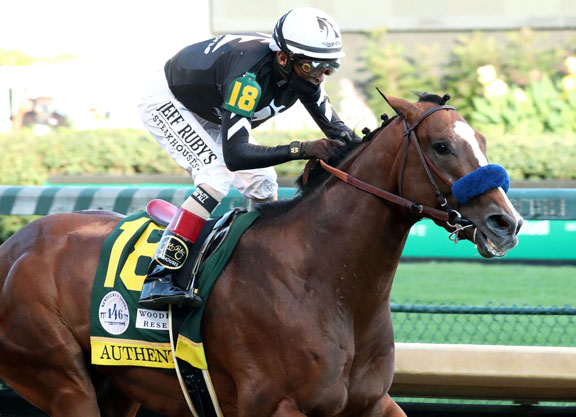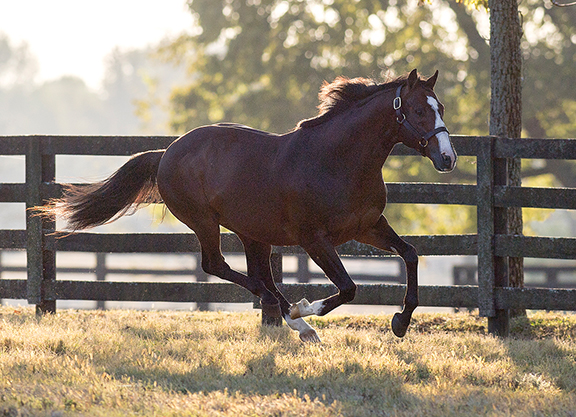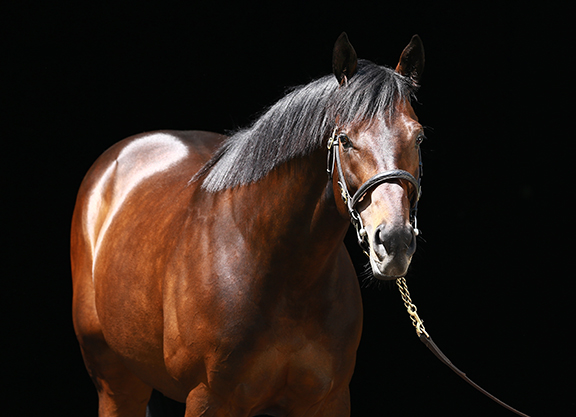Frankel (GB) has recaptured the crown he first wore in 2021 and is the champion sire in Britain and Ireland for 2023, as well as being the leading sire in Europe, for the second time. It won't be the last.
Whether or not he will be able to emulate the long reigns of his sire Galileo (Ire) and grandsire Sadler's Wells remains to be seen, but it would be unwise to bet against it. Yes, Frankel's launch into his stud career was the stallion equivalent of being born with a silver spoon in his mouth, so great was the support from major international breeders from the outset, but there have been plenty of examples of that not equating to a horse becoming a top sire. Frankel is just that, any way you look at it.
He is quickly being joined at stud by a number of his best sons, and there are plenty to choose from. This year alone in Britain, the trio of Chaldean (GB), Mostahdaf (Ire) and Triple Time (Ire) join the Newmarket powerhouses of Juddmonte, Shadwell and Darley, while Onesto (Ire) is now at Haras d'Etreham in France. Irish Derby winner Hurricane Lane (Ire) joins the National Hunt ranks where St Leger winner Logician (GB) already resides, and Derby winner Adayar (Ire) and another Irish Derby winner, Westover (GB), have headed east to Japan. That's seven new Group 1-winning sons of Frankel in one year's intake alone.
Frankel has won this year's championship in a manner not dissimilar to his performances on the track: by a wide margin. His progeny earnings in Britain and Ireland of just over £7 million put him almost £3 million clear of last year's champion Dubawi (Ire), with a margin of roughly £30,000 separating the runner-up and third-placed Dark Angel (Ire). In fact, it was pretty tightly packed among the first six horses in Frankel's wake.
To return to the champion momentarily, his 39 stakes winners worldwide in 2023 (23 in Britain and Ireland) included his 2,000 Guineas winner Chaldean, who now stands alongside him at Banstead Manor Stud, Soul Sister (GB), who became his second winner of the Oaks, Inspiral (GB), who recorded her sixth Group/Grade 1 win at Santa Anita at the Breeders' Cup, and her fellow Group 1 winners Nashwa (GB) and Jannah Rose (Ire). Three of these four fillies/mares remain in training, with Jannah Rose's immediate future yet to be decided.
Dubawi is also not short of the company of his sons at stud either. On the Darley roster alone, there is Night Of Thunder (Ire) (who is 12th on this year's table), along with Ghaiyyath (Ire), Space Blues (Ire) and Too Darn Hot (GB), and that group has been bolstered by the arrival of Modern Games (Ire), a Group/Grade 1 winner at two, three and four. Dubawi's wide-margin G1 National S. winner Henry Longfellow (Ire), out of the champion mare Minding (Ire) (Galileo {Ire}, should be high among his Classic colts to follow next year.
Good old Dark Angel. There is little doubt that his books will have risen in quality over the years but he would not be covering as many bluebloods as Frankel and Dubawi. He has been in the top seven sires in the last six years and takes third again, equalling his best performance of 2020. The six-year-old Art Power (Ire) typifies Dark Angel's profile as a sire who provides stock that are generally fast and hardy. Art Power is classy too, and he brought the curtain down on a good year for his father with victory in the G1 QIPCO British Champions Sprint.
Three of the stallions to have finished in the top 20 in Britain and Ireland for the year are no longer with us. Galileo (Ire), for so long such a dominant force in Europe, and Deep Impact (Jpn), of whom the same can be said in Japan, died in 2021 and 2019 respectively. Recently Ballyhane Stud lost its stalwart Dandy Man (Ire), who ends this year in 19th place in the table and was one of only five stallions to sire 100 or more winners this year.
Galileo, 12 times the champion sire, took the fourth spot, with the dual Group 1 winner Warm Heart (Ire) being his stand-out performer of the year from his 15 stakes winners in Britain and Ireland, which put him third in this sector behind only Frankel and Dubawi.
Not surprisingly, Deep Impact had only 11 runners in Britain and Ireland this year, but four of them won, and when one of those is the dual Derby and Irish Champion S. winner Auguste Rodin (Ire) then a decent slot in the table is guaranteed. The late Shadai stallion duly finished in 13th place.
In fifth was France's leading sire Siyouni (Fr), who had another banner year beyond his home country, with Paddington (GB) and Tahiyra (Fr) winning the Irish 2,000 and 1,000 Guineas respectively, before landing another five Group 1 victories between them. Paddington becomes the third son of Siyouni to join the Coolmore roster after Sottsass (Fr) and St Mark's Basilica (Fr).
Galileo's half-brother Sea The Stars (Ire) ensured that two Aga Khan Studs stallions made the top six. King George hero Hukum (Ire) was of course his best runner. He is now at stud in Japan, while we live in hope that the G1 Coronation Cup winner Emily Upjohn (GB) returns to training next year having not been seen since finishing seventh behind Hukum at Ascot in July.
The 103 British and Irish winners (and 11 stakes winners) for Kingman (GB) this year came at a 50% strike-rate to put him in seventh position, one ahead of the prolific Kodiac (GB), who is the leader by number of winners on 118 and was also represented by nine stakes winners.
Lope De Vega (Ire) was another member of the quintet with winners into three figures – 101 and eight stakes winners. No Nay Never completes the top ten with nine stakes winners to his credit, including new Coolmore stallion Little Big Bear (Ire).
Of those bubbling just under, it is hard not to think that we won't see Wootton Bassett (GB) shooting up the charts from next year. His 11th place finish in 2023 came from just 58 runners in Britain and Ireland, around a quarter of the number fielded by most of those names above him.
From 2024, we will see the first two-year-old runners to have been conceived following his move to Ireland, and Wootton Bassett was represented by three new Group/Grade 1 winners this year in three different countries. The hugely likeable King Of Steel was his real talking horse, and he returns next year, along with the Classic prospect Unquestionable (Fr) and Bucanero Fuerte (GB).
The dependable Derby winners Australia (GB) and Camelot (GB) were also in the top 20, along with Classic sire Nathaniel (Ire), who is surely one of the best value elite stallions in Britain.
An honourable mention must also go to Havana Grey (GB), who in 16th was the youngest of the top 20 finishers with only two crops to have raced for him so far, and eight stakes winners to his credit this year. And let's not forget Muhaarar (GB), which is what many perhaps tried to do when he left Shadwell to stand at Haras des Faunes in France in 2022. Now that people have worked out that most of his progeny are not sprinters, as he was, we can also admit that he's not a bad sire at all. He's had a jolly good year, in fact, with Poule d'Essai des Poulains winner Marhaba Ya Sanafi (Ire) leading the charge and backed up by G2 Princess of Wales S. winner Israr (GB) and Group/Grade 3 winners Annaf (Ire) and Motorious (GB) among his nine stakes winners worldwide (four in Britain in Ireland). Muhaarar is on the move again and will stand at Haras de Petit Tellier in 2024.
France and Germany
The Prix de l'Arc de Triomphe is such a valuable race that it usually guarantees French champion status (or thereabouts) to the sire of the winner.
Last year Frankel took the title, thanks largely to his wonderful daughter Alpinista (GB) but this year he has to play second fiddle to his son Cracksman (GB), sire of the brilliant Ace Impact (Ire). Frankel's influence loomed large in the Arc trifecta, with his sons Westover and Onesto taking second and third.
Of the stallions standing in France, Siyouni continues to stand tall and was third in the French table overall, with his daughter Mqse De Sevigne (Fr) landing a notable Group 1 double for her owner-breeder, the outgoing France Galop president Edouard de Rothschild. Siyouni notched the highest number of winners (66), and had Wootton Bassett just behind him in the table in fourth.
Next for the home team came Anodin (Ire), who was sixth overall with 60 winners and his first Group 1 winner, King Gold (Fr), in the Prix Maurice de Gheest. Dabirsim (Fr), now at Haras de Montaigu and sire of the multiple group winner Horizon Dore (Fr) this year, came next, while Zarak (Fr), another to have a first Group 1 winner his year when Zagrey (Fr) won the Grosser Preis von Baden, was ninth overall.
It is worth noting that, along with Zagrey, Zarak had another seven group winners this year: three more in Germany, and one in America. This unsurprisingly put him high in the German table in fourth position, with Straight (Ger) having won the G2 Union Rennen, while Shagara (Ire) won the G3 Preis der Winterkonigin and Princess Zelda (Ger) took the G3 Mehl-Mulhens-Trophy.
King of the hill in Germany, however, was Sea The Moon (Ger), which is no surprise given that he supplied the G1 Deutsches Derby winner Fantastic Moon (Ger) and the first three home in the G1 Preis der Diana, led by Muskoka (Ger). The Lanwades resident had another three group winners in Germany in 2023, as well as one each in Ireland, America and Italy.
Separating Sea The Moon and Zarak was the late duo of Areion (Ger) and Adlerflug (Ger), and special mention must go to Iquitos (Ger), who finished seventh in the table despite having had just five runners. That quintet included the stakes winners Mr Hollywood (Ire) and Drawn To Dream (Ire), both bred by Gestut Ammerland from Hurricane Run (Ire) mares.
The post Frankel Waltzes to a Second Sires’ Championship appeared first on TDN | Thoroughbred Daily News | Horse Racing News, Results and Video | Thoroughbred Breeding and Auctions.





